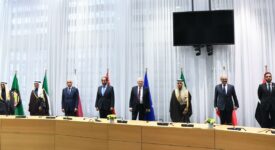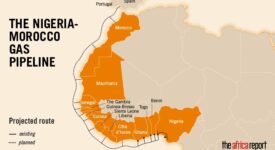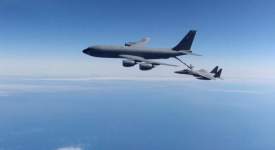A decade after the start of the Arab Spring, volatility has not abated in North Africa, while the armies are still far from striking a balance between responding to terrorist and hybrid threats. The long-lasting consequences of the Arab Spring’s second wave — which significantly undermined the Algerian regime and caused the fall of President Omar al-Bashir in Sudan between 2018 and 2019 — are clear indicators. At the same time, renewed fighting in Libya has resulted in the internationalisation of the conflict, sowing the seeds of further instability in the region and beyond; while the normalisation process between Israel and several Arab states stemming from the Abraham Accords reverberated up to Western Sahara, where tensions between Morocco and the Polisario Front escalated. In the meantime, the COVID-19 pandemic acted as an accelerator for pre-existing geopolitical trends, driving the region away from the war-on-terrorism paradigm that followed 9/11 to an era of great power competition. This shift is highlighted not only by the multiple state interventions and the increasing assertiveness of regional actors, but also by the skillful use of soft power instruments such as vaccine diplomacy.
THE RISE OF HYBRID THREATS — Although counterterrorism is likely to remain the main security priority for the time being, the armies in the region still have to adapt to this paradigm shift, promoting a gradual recalibration of their strategic posture in an ever-challenging security landscape. Indeed, the most recent foreign intervention in the region was modelled around the hybrid warfare concept, one in which foreign meddlers have successfully blended different tools combining conventional, irregular, and cyber warfare among other instruments. Libya is a case in point as shown not only by the proxy dynamics that have informed the relationship between local militias and the foreign sponsors, but also by the use of Private Military Companies (PMCs) such as the Russian Wagner Group and the Turkish SADAT; the recruitment of mercenaries from Syria by both rival coalitions; the presence of Non-State Armed Groups (NSAGs) and rebel forces from neighbouring countries; and the attempt to influence the outcome of the electoral process by cultivating close relations with potential candidates, such as Saif al-Islam Gadhafi.
THE HYBRID SECURITY LANDSCAPE IN LIBYA — Obviously, Libya represents a peculiar case: the hybrid warfare that characterised recent foreign interventions mirrors a hybrid security landscape in which the collapse of the state apparatus, after the fall of Muammar Gadhafi, led to a proliferation of militias and armed groups with competing claims over legitimacy and the monopoly of the use of force. The latest round of infighting has led to a military stalemate that has been beneficial to the UN-sponsored peace process, raising hopes for a prompt end to the unfinished transition after ten years of civil war. However, the reversal of the fragmentation trend highlighted by the establishment of a Government of National Unity (GNU), has been so far contained to a political dimension that, albeit important, is yet to address the multiple hybrid threats hanging over Libya. Centripetal forces have stopped short of implementing the much-awaited Security Sector Reforms (SSRs) and Disarmament, Demobilisation and Reintegration (DDR) programmes — preliminary steps that would ultimately lead to the reunification of the military. Instead, the persisting Libyan Armed Forces (LAF)-Libyan National Army (LNA) duopoly spells troubles for the future of the country, threatening its unity and making a frozen conflict scenario a real possibility.
THE DESTABILISATION OF THE DEEP MAGHREB — Libya’s persisting lack of rule of law and its porous borders are coupled with the presence of NSAGs and mercenaries, representing a formidable threat to the security of neighbouring countries. The incursion of the Fronte pour l’alternance et la concorde au Tchad (FACT) from Libya to Chad in April 2021 is yet another example of the destabilising consequences of this explosive mix, which goes well beyond the Maghreb region. The very presence of FACT in Libyan military bases such as Jufra alongside the Wagner Group has led to speculations about Wagner operatives having provided training to FACT militants. In such a hybrid scenario, FACT’s attack exceeds conventional insurgency and could instead be interpreted in geopolitical terms, considering the blurred lines between the foreign policy of the Russian state and the activities of Russian PMCs. Resulting in the death of the Chadian President Idriss Déby Itno, FACT’s attack also brought to the fore the importance of the Deep Maghreb, a new regional concept that better illustrates the complementarity and interconnectedness of the Maghreb and the Sahel sub-regions, bonded by common security issues, social factors, trade, and economic interests.
THE STRATEGIC CENTRALITY OF ALGERIA — In the Deep Maghreb, the priority given to counterterrorism so far is increasingly challenged by new hybrid threats. For now, this trend has been much more visible in the Maghreb, also due to the magnitude of the terrorist threat in the Sahel. In fact, the rise of the Islamic State in the Greater Sahara (ISGS) and Jama’at Nasr al-Islam wal Mulsimin (JNIM) has partially offset the gradual decline of al-Qaeda in the Islamic Maghreb (AQIM), while successive counterterrorism campaigns have severely diminished the branch of the Islamic State in Libya. In this ever-changing context, the strategic centrality of Algeria stands out: recent constitutional amendments seem in line with the aforementioned paradigm shift. The provision allowing the Armée Nationale Populaire (ANP) to be deployed outside the national territory for peacekeeping missions represents a considerable diversion from the traditional non-interventionist doctrine of the Algerian army. More importantly, this constitutional change seems to respond more to the security concerns stemming from the geopolitical competition over neighbouring Libya rather than the more conventional terrorist threat. Whether or not the army embraces a doctrinal change that could have been considered a heresy in Algiers only a few years ago remains to be seen, but the move is certainly emblematic and, to a certain extent, could help shape a new regional background in which local players act as security providers.
COOPERATION AND MISTRUST IN THE MAGHREB — In this context, the Algerian military is already engaging with regional partners such as Tunisia, capitalizing on the expertise acquired in mitigating the terrorist threat during the so-called ‘black decade’ in the 1990s. Their bilateral security partnership has been intensified in recent years, while their security cooperation has been instrumental in weakening terrorist groups such as the AQIM-affiliated Okba Ibn Nafaa Brigade, active in the Chaambi Mountains. Further West, however, the uneasy relations between Algeria and Morocco are preventing security cooperation, as highlighted by a recent interview to the new head of the Bureau Centrale des Investigations Judiciaires (BCIJ) Cherkaoui Habboub. Recent allegations about a close cooperation between the Polisario Front and terrorist organisations such as AQIM and ISGS follow Rabat’s accusations against Iran of arming the movement for the independence of Western Sahara through Hezbollah, while Algeria’s long-standing support for the Polisario is certainly much more in line with a proxy war dynamic. In such a complex environment, Morocco’s procurement and use of unmanned aerial vehicles (UAVs) in Western Sahara highlights an emerging trend in the security hybridisation age in the Maghreb. Together with the privatisation of warfare, underlined by the use of PMCs and mercenaries in conflict theatres, remote warfare represents a tangible aspect of this new security landscape, providing an important tool to the military both for counterterrorism purposes and to respond to hybrid challenges.
‚Deep Maghreb: Striking a Balance Between Terrorist and Hybrid Threats‘ –Commentary by Umberto Profazio – Italian Institute for International Political Studies / ISPI.
The Commentary can be downloaded here







